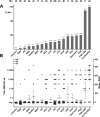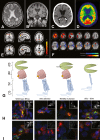High prevalence of NMDA receptor IgA/IgM antibodies in different dementia types
- PMID: 25493273
- PMCID: PMC4241809
- DOI: 10.1002/acn3.120
High prevalence of NMDA receptor IgA/IgM antibodies in different dementia types
Abstract
Objective: To retrospectively determine the frequency of N-Methyl-D-Aspartate (NMDA) receptor (NMDAR) autoantibodies in patients with different forms of dementia.
Methods: Clinical characterization of 660 patients with dementia, neurodegenerative disease without dementia, other neurological disorders and age-matched healthy controls combined with retrospective analysis of serum or cerebrospinal fluid (CSF) for the presence of NMDAR antibodies. Antibody binding to receptor mutants and the effect of immunotherapy were determined in a subgroup of patients.
Results: Serum NMDAR antibodies of IgM, IgA, or IgG subtypes were detected in 16.1% of 286 dementia patients (9.5% IgM, 4.9% IgA, and 1.7% IgG) and in 2.8% of 217 cognitively healthy controls (1.9% IgM and 0.9% IgA). Antibodies were rarely found in CSF. The highest prevalence of serum antibodies was detected in patients with "unclassified dementia" followed by progressive supranuclear palsy, corticobasal syndrome, Parkinson's disease-related dementia, and primary progressive aphasia. Among the unclassified dementia group, 60% of 20 patients had NMDAR antibodies, accompanied by higher frequency of CSF abnormalities, and subacute or fluctuating disease progression. Immunotherapy in selected prospective cases resulted in clinical stabilization, loss of antibodies, and improvement of functional imaging parameters. Epitope mapping showed varied determinants in patients with NMDAR IgA-associated cognitive decline.
Interpretation: Serum IgA/IgM NMDAR antibodies occur in a significant number of patients with dementia. Whether these antibodies result from or contribute to the neurodegenerative disorder remains unknown, but our findings reveal a subgroup of patients with high antibody levels who can potentially benefit from immunotherapy.
Figures



References
-
- Flanagan EP, Caselli RJ. Autoimmune encephalopathy. Semin Neurol. 2011;31:144–157. - PubMed
-
- Lyons MK, Caselli RJ, Parisi JE. Nonvasculitic autoimmune inflammatory meningoencephalitis as a cause of potentially reversible dementia: report of 4 cases. J Neurosurg. 2008;108:1024–1027. - PubMed
-
- McKeon A, Marnane M, O’connell M, et al. Potassium channel antibody associated encephalopathy presenting with a frontotemporal dementia like syndrome. Arch Neurol. 2007;64:1528–1530. - PubMed
Grants and funding
LinkOut - more resources
Full Text Sources
Other Literature Sources
Miscellaneous

